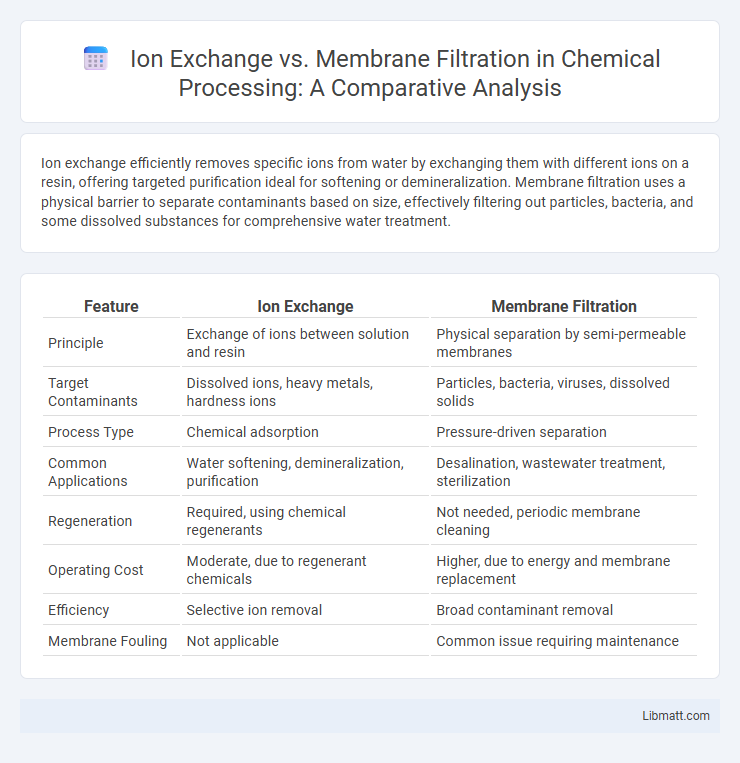Ion exchange efficiently removes specific ions from water by exchanging them with different ions on a resin, offering targeted purification ideal for softening or demineralization. Membrane filtration uses a physical barrier to separate contaminants based on size, effectively filtering out particles, bacteria, and some dissolved substances for comprehensive water treatment.
Table of Comparison
| Feature | Ion Exchange | Membrane Filtration |
|---|---|---|
| Principle | Exchange of ions between solution and resin | Physical separation by semi-permeable membranes |
| Target Contaminants | Dissolved ions, heavy metals, hardness ions | Particles, bacteria, viruses, dissolved solids |
| Process Type | Chemical adsorption | Pressure-driven separation |
| Common Applications | Water softening, demineralization, purification | Desalination, wastewater treatment, sterilization |
| Regeneration | Required, using chemical regenerants | Not needed, periodic membrane cleaning |
| Operating Cost | Moderate, due to regenerant chemicals | Higher, due to energy and membrane replacement |
| Efficiency | Selective ion removal | Broad contaminant removal |
| Membrane Fouling | Not applicable | Common issue requiring maintenance |
Introduction to Water Purification Technologies
Ion exchange and membrane filtration are key water purification technologies designed to remove contaminants and improve water quality. Ion exchange efficiently targets dissolved ions like hardness minerals and heavy metals by exchanging them with benign ions, making it ideal for softening and demineralization. Membrane filtration uses selective barriers such as microfiltration, ultrafiltration, nanofiltration, or reverse osmosis to remove particles, microbes, and dissolved solids, offering comprehensive purification for various water treatment needs.
Overview of Ion Exchange Process
Ion exchange is a water treatment process where undesirable ions are replaced with more desirable ones using resin beads charged with specific ions. This method efficiently removes hardness, heavy metals, and contaminants from water by exchanging ions such as calcium and magnesium for sodium or hydrogen ions. Ion exchange systems are widely used in applications ranging from water softening to industrial purification due to their selectivity and cost-effectiveness.
Fundamentals of Membrane Filtration
Membrane filtration relies on semi-permeable membranes to separate particles, ions, and molecules based on size exclusion and selective permeability, making it ideal for removing suspended solids and microorganisms. This process includes microfiltration, ultrafiltration, nanofiltration, and reverse osmosis, each distinguished by pore size and specific applications, enabling tailored water or wastewater treatment solutions. Your choice of membrane filtration offers a low-chemical alternative to ion exchange, enhancing purification efficiency while reducing operational costs.
Key Differences Between Ion Exchange and Membrane Filtration
Ion exchange separates ions based on charge affinity using resin beds, effectively removing hardness, heavy metals, and nitrates, while membrane filtration employs physical barriers like reverse osmosis or ultrafiltration to exclude particles, bacteria, and dissolved solids. Ion exchange requires periodic regeneration with chemicals, whereas membrane filtration involves backwashing and can retain a broader range of contaminants, including salts and organic molecules. Your choice depends on specific water quality goals, with ion exchange excelling in targeted ion removal and membrane filtration providing comprehensive purification.
Applications of Ion Exchange in Industry
Ion exchange technology is widely used in industries such as water treatment, pharmaceuticals, food and beverage processing, and chemical manufacturing to remove unwanted ions and purify liquids. It effectively softens water, demineralizes solutions, and recovers valuable metals, enhancing product quality and operational efficiency. Your industrial processes benefit from ion exchange's ability to selectively target contaminants, ensuring consistent purity and environmental compliance.
Uses of Membrane Filtration in Water Treatment
Membrane filtration is widely used in water treatment to remove pathogens, suspended solids, and dissolved contaminants, providing high-quality potable water. Technologies such as microfiltration, ultrafiltration, nanofiltration, and reverse osmosis target specific particle sizes and chemical compounds, enhancing purification efficiency. Your water treatment system can benefit from membrane filtration's ability to produce consistent clean water with reduced chemical usage compared to ion exchange methods.
Efficiency and Performance Comparison
Ion exchange excels at removing specific ions such as calcium, magnesium, and heavy metals, offering high selectivity and regeneration capabilities that maintain consistent performance over time. Membrane filtration, including reverse osmosis and ultrafiltration, provides broader contaminant removal with efficiency dependent on membrane pore size and pressure conditions but may require frequent maintenance to prevent fouling. Your choice depends on whether targeted ion removal or comprehensive filtration is prioritized, balancing operational costs and desired water quality outcomes.
Cost Considerations: Ion Exchange vs Membrane Filtration
Ion exchange systems generally have lower upfront costs but higher ongoing expenses due to resin replacement and chemical regeneration, affecting long-term operational budgets. Membrane filtration involves higher initial capital investment for equipment and installation but often offers lower maintenance costs and energy consumption over time. Cost efficiency depends on factors like water quality, treatment scale, and desired purity levels, making site-specific analysis crucial for optimal financial planning.
Environmental Impact and Sustainability
Ion exchange and membrane filtration both offer sustainable water treatment solutions, but their environmental impacts differ significantly. Ion exchange resin regeneration often produces chemical waste, requiring careful handling to minimize environmental harm, whereas membrane filtration generally has a lower chemical footprint and can reduce energy consumption with improved membrane technologies. Membrane filtration systems contribute to sustainability goals through higher efficiency and less chemical use, making them preferable for eco-friendly water purification.
Choosing the Right Technology for Your Needs
Selecting between ion exchange and membrane filtration depends on water quality goals and specific contaminants targeted. Ion exchange excels in removing dissolved ions like hardness and heavy metals, offering precise ion-specific treatment, while membrane filtration effectively eliminates particulates, microbes, and a broad spectrum of dissolved solids through physical separation. Evaluating factors such as water composition, treatment capacity, operational costs, and maintenance requirements guides the optimal choice for industrial, municipal, or residential water purification systems.
Ion exchange vs membrane filtration Infographic

 libmatt.com
libmatt.com